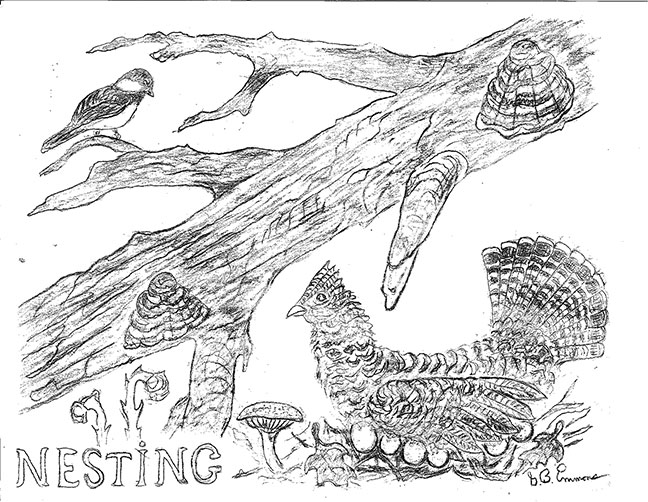The Ground Nesting Partridge in spring is hard to locate and identify because the color of its plumage is camouflaged with one of two earthly color phases.
Here in New England, the Partridge feathers match the dark gray shadows of the surrounding conifer forest. Further south, the Partridge plumage has a rusty cast to match the brick-colored, red-earth shade of more colorful soil below the Mason Dixon line. Either one of the two Partridge camouflaged shades can readily be recognized in the feathers of a Ground Nesting Partridge.
As in my illustration, the mother Partridge is sitting on a clutch of six eggs that she started incubating after they were all laid so that all would hatch out at about the same time. Then all would match the others and coincide with one of the two earthly colors. Both can be easily identified to match the nesting Partridge coloring that came about from the geographic origin of the Partridge ground nesting location at the time the eggs were laid and incubated.
The mother Partridge, out of habit, builds a bowl-shaped nest of sticks so she can pluck loose vegetation into it because it probably contains high-level protein and rich vitamins to grow on and develop into bigger fledglings.
They quickly learn to move about into groves of aspen, pine and birch, and later to develop an appetite for fruit buds, ferns and shrub berries and then later in the season nuts and acorns that have a high content of cellulose, which after digesting makes it later possible to survive harsh, winter-weather conditions.
Even after forced to move about more than a half-mile for a plentiful, unexpected, different food supply that pops up, their location is observed by a nearby Partridge drumming male that has no secrecy by loudly making his observation known. When he may mount a hollow log as a convenient drum, he can thunder some 40 wingbeats against his chest that sounds like some person trying to start up a two-cycle engine with a sputtering burst of a loud static tattoo.
The plump Partridge has a cocky crest on its head and a tail marked with a broad, dark band near the tip, which when displayed gives the displaying male a rich, black ruff around the neck, giving it the well-known other name of “Ruffed Grouse.“
The thumping, rousing beating like a drum carries up to a quarter of a mile and announces its message like a barnyard rooster beating its chest like Chaucer’s Chanticleer literary bugle announcement of the coming dawn of a new day.
By George B. Emmons
